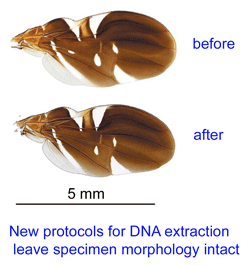 Reference databases of DNA sequences used for species identification, ie DNA barcode libraries, are most powerful when the morphologic specimens are vouchered in a museum collection. This way, when there are puzzling results, DNA and morphologic specimens can be re-examined. However to date it has been challenging to recover DNA from small organisms without destroying them in the process.
Reference databases of DNA sequences used for species identification, ie DNA barcode libraries, are most powerful when the morphologic specimens are vouchered in a museum collection. This way, when there are puzzling results, DNA and morphologic specimens can be re-examined. However to date it has been challenging to recover DNA from small organisms without destroying them in the process.
In Mol Ecol Notes 9 aug 2007 researchers from US Department Agriculture and Smithsonian Institution, National Museum of Natural History, describe a uniform protocol for “nondestructive extraction of DNA from terrestrial arthropods” including ticks, spiders, beetles, flies, and bees. 1 to 4 h in a guanidium thiocyanate extraction buffer yielded amplifiable COI DNA from most specimens. Inspection of specimens after extraction including with phase contrast and scanning electron microscopy demonstrated preservation of most morphologic characters.
In Mol Ecol Notes 27 june 2007, UK researchers (University College, London, NERC Centre for Ecology and Hydrology, Oxford, and UK Environmental Agency) describe a rapid, non-destructive, chemical-free method for DNA recovery from blackflies, including adult, larval, and pupal forms. Hunter et al report brief (1 minute) sonication in sterile water yielded 66% success with COI barcode amplification and preserved morphologic details.
These reports are exciting in the methods they describe and in how they highlight the general value of extracting DNA and determining DNA barcode sequences as an integral part of preparing traditional morphologic vouchers.
I wondered whether DNA extracted with these sort of method could be stable and easily -conserved since the impurity is also contained in the extraction buffer. Furthermore,can the specimen which have been processed still be available for DNA extraction for the second time after a period of time?
Well, I’m a new newcomer and wish your asist and review.
By the way, I like this blog very much.thanks Mr.mark stoeckle who has contributed a lot to it. I appreciate your work . Wish the blog updates more quickly.